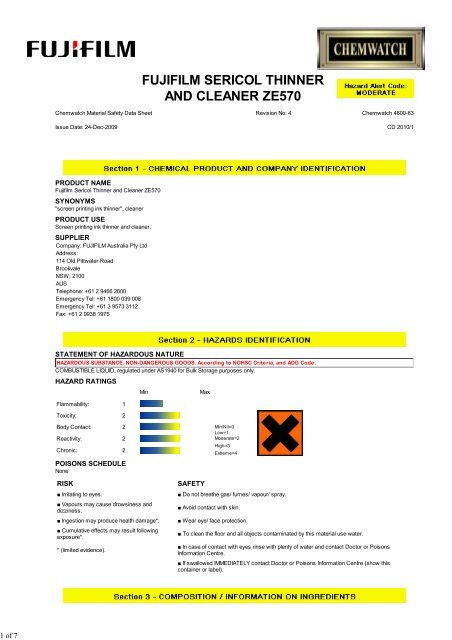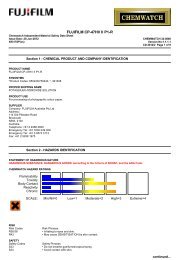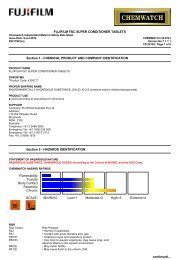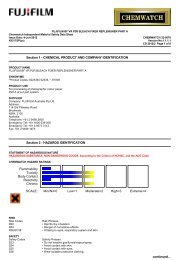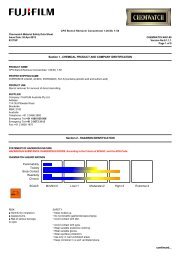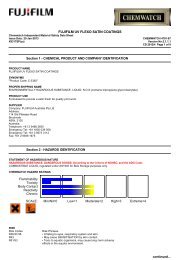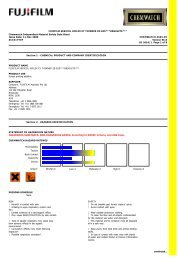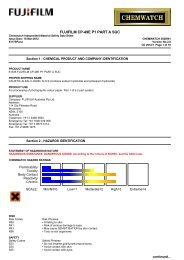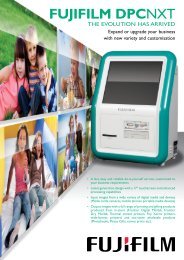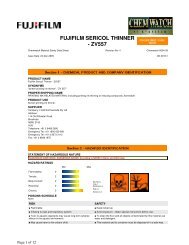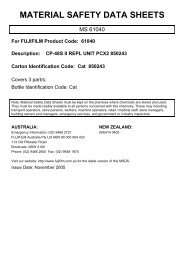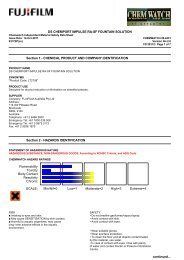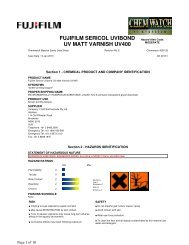fujifilm sericol thinner and cleaner ze570 - FUJIFILM Australia
fujifilm sericol thinner and cleaner ze570 - FUJIFILM Australia
fujifilm sericol thinner and cleaner ze570 - FUJIFILM Australia
You also want an ePaper? Increase the reach of your titles
YUMPU automatically turns print PDFs into web optimized ePapers that Google loves.
1 of 7<br />
<strong>FUJIFILM</strong> SERICOL THINNER<br />
AND CLEANER ZE570<br />
Chemwatch Material Safety Data Sheet Revision No: 4 Chemwatch 4600-63<br />
Issue Date: 24-Dec-2009 CD 2010/1<br />
PRODUCT NAME<br />
Fujifilm Sericol Thinner <strong>and</strong> Cleaner ZE570<br />
SYNONYMS<br />
"screen printing ink <strong>thinner</strong>", <strong>cleaner</strong><br />
PRODUCT USE<br />
Screen printing ink <strong>thinner</strong> <strong>and</strong> <strong>cleaner</strong>.<br />
SUPPLIER<br />
Company: <strong>FUJIFILM</strong> <strong>Australia</strong> Pty Ltd<br />
Address:<br />
114 Old Pittwater Road<br />
Brookvale<br />
NSW, 2100<br />
AUS<br />
Telephone: +61 2 9466 2600<br />
Emergency Tel: +61 1800 039 008<br />
Emergency Tel: +61 3 9573 3112<br />
Fax: +61 2 9938 1975<br />
STATEMENT OF HAZARDOUS NATURE<br />
HAZARDOUS SUBSTANCE. NON-DANGEROUS GOODS. According to NOHSC Criteria, <strong>and</strong> ADG Code.<br />
COMBUSTIBLE LIQUID, regulated under AS1940 for Bulk Storage purposes only.<br />
HAZARD RATINGS<br />
Flammability: 1<br />
Toxicity: 2<br />
Min<br />
Max<br />
Body Contact: 2<br />
Reactivity: 2<br />
Chronic: 2<br />
POISONS SCHEDULE<br />
None<br />
RISK<br />
■ Irritating to eyes.<br />
■ Vapours may cause drowsiness <strong>and</strong><br />
dizziness.<br />
■ Ingestion may produce health damage*.<br />
■ Cumulative effects may result following<br />
exposure*.<br />
* (limited evidence).<br />
SAFETY<br />
Min/Nil=0<br />
Low=1<br />
Moderate=2<br />
High=3<br />
Extreme=4<br />
■ Do not breathe gas/ fumes/ vapour/ spray.<br />
■ Avoid contact with skin.<br />
■ Wear eye/ face protection.<br />
■ To clean the floor <strong>and</strong> all objects contaminated by this material use water.<br />
■ In case of contact with eyes rinse with plenty of water <strong>and</strong> contact Doctor or Poisons<br />
Information Centre.<br />
■ If swallowed IMMEDIATELY contact Doctor or Poisons Information Centre (show this<br />
container or label).
2 of 7<br />
<strong>FUJIFILM</strong> SERICOL THINNER<br />
AND CLEANER ZE570<br />
Chemwatch Material Safety Data Sheet Revision No: 4 Chemwatch 4600-63<br />
Issue Date: 24-Dec-2009 CD 2010/1<br />
NAME CAS RN %<br />
diethylene glycol monoethyl ether 111-90-0 >50<br />
other non hazardous ingredients
3 of 7<br />
<strong>FUJIFILM</strong> SERICOL THINNER<br />
AND CLEANER ZE570<br />
Chemwatch Material Safety Data Sheet Revision No: 4 Chemwatch 4600-63<br />
Issue Date: 24-Dec-2009 CD 2010/1<br />
None<br />
PERSONAL PROTECTION<br />
Glasses: Gloves: Respirator:<br />
Safety Glasses. PVC chemical resistant type. Type A Filter of sufficient capacity<br />
EMERGENCY PROCEDURES<br />
MINOR SPILLS<br />
■<br />
Remove all ignition sources.<br />
Clean up all spills immediately.<br />
Avoid breathing vapours <strong>and</strong> contact with skin <strong>and</strong> eyes.<br />
Control personal contact by using protective equipment.<br />
Contain <strong>and</strong> absorb spill with s<strong>and</strong>, earth, inert material or vermiculite.<br />
Wipe up.<br />
Place in a suitable, labelled container for waste disposal.<br />
MAJOR SPILLS<br />
■ Moderate hazard.<br />
Clear area of personnel <strong>and</strong> move upwind.<br />
Alert Fire Brigade <strong>and</strong> tell them location <strong>and</strong> nature of hazard.<br />
Wear breathing apparatus plus protective gloves.<br />
Prevent, by any means available, spillage from entering drains or water course.<br />
No smoking, naked lights or ignition sources.<br />
Increase ventilation.<br />
Stop leak if safe to do so.<br />
Contain spill with s<strong>and</strong>, earth or vermiculite.<br />
Collect recoverable product into labelled containers for recycling.<br />
Absorb remaining product with s<strong>and</strong>, earth or vermiculite.<br />
Collect solid residues <strong>and</strong> seal in labelled drums for disposal.<br />
Wash area <strong>and</strong> prevent runoff into drains.<br />
If contamination of drains or waterways occurs, advise emergency services.<br />
Personal Protective Equipment advice is contained in Section 8 of the MSDS.<br />
PROCEDURE FOR HANDLING<br />
■ The tendency of many ethers to form explosive peroxides is well documented. Ethers lacking non-methyl hydrogen atoms adjacent to the ether<br />
link are thought to be relatively safe<br />
DO NOT concentrate by evaporation, or evaporate extracts to dryness, as residues may contain explosive peroxides with DETONATION<br />
potential.<br />
Any static discharge is also a source of hazard.<br />
Before any distillation process remove trace peroxides by shaking with excess 5% aqueous ferrous sulfate solution or by percolation through a<br />
column of activated alumina.<br />
Distillation results in uninhibited ether distillate with considerably increased hazard because of risk of peroxide formation on storage.<br />
Add inhibitor to any distillate as required.<br />
When solvents have been freed from peroxides by percolation through columns of activated alumina, the absorbed peroxides must promptly<br />
be desorbed by treatment with polar solvents such as methanol or water, which should then be disposed of safely.<br />
The substance accumulates peroxides which may become hazardous only if it evaporates or is distilled or otherwise treated to concentrate the<br />
peroxides. The substance may concentrate around the container opening for example.<br />
Purchases of peroxidisable chemicals should be restricted to ensure that the chemical is used completely before it can become peroxidised.<br />
A responsible person should maintain an inventory of peroxidisable chemicals or annotate the general chemical inventory to indicate which<br />
chemicals are subject to peroxidation. An expiration date should be determined. The chemical should either be treated to remove peroxides or<br />
disposed of before this date.<br />
The person or laboratory receiving the chemical should record a receipt date on the bottle. The individual opening the container should add an<br />
opening date.<br />
Unopened containers received from the supplier should be safe to store for 18 months.<br />
Opened containers should not be stored for more than 12 months.<br />
Avoid all personal contact, including inhalation.<br />
Wear protective clothing when risk of exposure occurs.<br />
Use in a well-ventilated area.<br />
Prevent concentration in hollows <strong>and</strong> sumps.<br />
DO NOT enter confined spaces until atmosphere has been checked.<br />
Avoid smoking, naked lights or ignition sources.<br />
Avoid contact with incompatible materials.
4 of 7<br />
<strong>FUJIFILM</strong> SERICOL THINNER<br />
AND CLEANER ZE570<br />
Chemwatch Material Safety Data Sheet Revision No: 4 Chemwatch 4600-63<br />
Issue Date: 24-Dec-2009 CD 2010/1<br />
When h<strong>and</strong>ling, DO NOT eat, drink or smoke.<br />
Keep containers securely sealed when not in use.<br />
Avoid physical damage to containers.<br />
Always wash h<strong>and</strong>s with soap <strong>and</strong> water after h<strong>and</strong>ling.<br />
Work clothes should be laundered separately.<br />
Use good occupational work practice.<br />
Observe manufacturer's storing <strong>and</strong> h<strong>and</strong>ling recommendations.<br />
Atmosphere should be regularly checked against established exposure st<strong>and</strong>ards to ensure safe working conditions.<br />
SUITABLE CONTAINER<br />
■<br />
DO NOT use aluminium or galvanised containers<br />
Metal can or drum<br />
Packaging as recommended by manufacturer.<br />
Check all containers are clearly labelled <strong>and</strong> free from leaks.<br />
STORAGE INCOMPATIBILITY<br />
■ Diethylene glycol monoethyl ether<br />
may produce unstable peroxides on prolonged storage<br />
reacts violently with strong oxidisers<br />
is incompatible with aliphatic amines, amides, sulfuric acid, nitric acid, caustics, isocyanates<br />
Glycol ethers may form peroxides under certain conditions; the potential for peroxide formation is enhanced when these substances are used<br />
in processes such as distillation where they are concentrated or even evaporated to near-dryness or dryness; storage under a nitrogen<br />
atmosphere is recommended to minimise the possible formation of highly reactive peroxides<br />
Nitrogen blanketing is recommended if transported in containers at temperatures within 15 deg C of the flash-point <strong>and</strong> at or above the<br />
flash-point - large containers may first need to be purged <strong>and</strong> inerted with nitrogen prior to loading<br />
In the presence of strong bases or the salts of strong bases, at elevated temperatures, the potential exists for runaway reactions.<br />
Contact with aluminium should be avoided; release of hydrogen gas may result- glycol ethers will corrode scratched aluminium surfaces.<br />
May discolour in mild steel/ copper; lined containers, glass or stainless steel is preferred<br />
Glycols <strong>and</strong> their ethers undergo violent decomposition in contact with 70% perchloric acid. This seems likely to involve formation of the glycol<br />
perchlorate esters (after scission of ethers) which are explosive, those of ethylene glycol <strong>and</strong> 3-chloro-1,2-propanediol being more powerful<br />
than glyceryl nitrate, <strong>and</strong> the former so sensitive that it explodes on addition of water . Investigation of the hazards associated with use of<br />
2-butoxyethanol for alloy electropolishing showed that mixtures with 50-95% of acid at 20 deg C, or 40-90% at 75 C, were explosive <strong>and</strong><br />
initiable by sparks. Sparking caused mixtures with 40-50% of acid to become explosive, but 30% solutions appeared safe under static<br />
conditions of temperature <strong>and</strong> concentration.<br />
Avoid reaction with oxidising agents<br />
STORAGE REQUIREMENTS<br />
■<br />
Store in original containers.<br />
Keep containers securely sealed.<br />
No smoking, naked lights or ignition sources.<br />
Store in a cool, dry, well-ventilated area.<br />
Store away from incompatible materials <strong>and</strong> foodstuff containers.<br />
Protect containers against physical damage <strong>and</strong> check regularly for leaks.<br />
Observe manufacturer's storing <strong>and</strong> h<strong>and</strong>ling recommendations.<br />
EXPOSURE CONTROLS<br />
The following materials had no OELs on our records<br />
• diethylene glycol monoethyl ether: CAS:111-90-0<br />
PERSONAL PROTECTION<br />
RESPIRATOR<br />
Type A Filter of sufficient capacity<br />
EYE<br />
■<br />
Safety glasses with side shields.<br />
Chemical goggles.<br />
Contact lenses may pose a special hazard; soft contact lenses may absorb <strong>and</strong> concentrate irritants. A written policy document, describing<br />
the wearing of lens or restrictions on use, should be created for each workplace or task. This should include a review of lens absorption <strong>and</strong>
5 of 7<br />
<strong>FUJIFILM</strong> SERICOL THINNER<br />
AND CLEANER ZE570<br />
Chemwatch Material Safety Data Sheet Revision No: 4 Chemwatch 4600-63<br />
Issue Date: 24-Dec-2009 CD 2010/1<br />
adsorption for the class of chemicals in use <strong>and</strong> an account of injury experience. Medical <strong>and</strong> first-aid personnel should be trained in their<br />
removal <strong>and</strong> suitable equipment should be readily available. In the event of chemical exposure, begin eye irrigation immediately <strong>and</strong> remove<br />
contact lens as soon as practicable. Lens should be removed at the first signs of eye redness or irritation - lens should be removed in a clean<br />
environment only after workers have washed h<strong>and</strong>s thoroughly. [CDC NIOSH Current Intelligence Bulletin 59]<br />
HANDS/FEET<br />
■ Suitability <strong>and</strong> durability of glove type is dependent on usage. Important factors in the selection of gloves include: such as:<br />
frequency <strong>and</strong> duration of contact,<br />
chemical resistance of glove material,<br />
glove thickness <strong>and</strong><br />
dexterity<br />
Select gloves tested to a relevant st<strong>and</strong>ard (e.g. Europe EN 374, US F739).<br />
When prolonged or frequently repeated contact may occur, a glove with a protection class of 5 or higher (breakthrough time greater than 240<br />
minutes according to EN 374) is recommended.<br />
When only brief contact is expected, a glove with a protection class of 3 or higher (breakthrough time greater than 60 minutes according to EN<br />
374) is recommended.<br />
Contaminated gloves should be replaced.<br />
Gloves must only be worn on clean h<strong>and</strong>s. After using gloves, h<strong>and</strong>s should be washed <strong>and</strong> dried thoroughly. Application of a non-perfumed<br />
moisturiser is recommended.<br />
Wear chemical protective gloves, eg. PVC.<br />
Wear safety footwear or safety gumboots, eg. Rubber<br />
OTHER<br />
■<br />
Overalls.<br />
P.V.C. apron.<br />
Barrier cream.<br />
Skin cleansing cream.<br />
Eye wash unit.<br />
ENGINEERING CONTROLS<br />
■ General exhaust is adequate under normal operating conditions. Local exhaust ventilation may be required in specific circumstances. If risk of<br />
overexposure exists, wear approved respirator. Correct fit is essential to obtain adequate protection. Provide adequate ventilation in warehouse or<br />
closed storage areas.<br />
APPEARANCE<br />
Colourless liquid with a characteristic odour; mixes with water.<br />
PHYSICAL PROPERTIES<br />
Liquid.<br />
Mixes with water.<br />
State Liquid Molecular Weight Not Applicable<br />
Melting Range (°C) -78 Viscosity Not Available<br />
Boiling Range (°C) 202 Solubility in water (g/L) Miscible<br />
Flash Point (°C) 93 pH (1% solution) Not Available<br />
Decomposition Temp (°C) Not Available pH (as supplied) Not Available<br />
Autoignition Temp (°C) Not Available Vapour Pressure (kPa) 0.026 @ 20C<br />
Upper Explosive Limit (%) Not Available Specific Gravity (water=1) 0.9885<br />
Lower Explosive Limit (%) Not Available Relative Vapour Density (air=1) Not Available<br />
Volatile Component (%vol) Not Available Evaporation Rate Not Available<br />
Material<br />
Value<br />
log Kow -0.79- -0.15<br />
CONDITIONS CONTRIBUTING TO INSTABILITY<br />
■<br />
Presence of incompatible materials.<br />
Product is considered stable.<br />
Hazardous polymerisation will not occur.<br />
For incompatible materials - refer to Section 7 - H<strong>and</strong>ling <strong>and</strong> Storage.
6 of 7<br />
<strong>FUJIFILM</strong> SERICOL THINNER<br />
AND CLEANER ZE570<br />
Chemwatch Material Safety Data Sheet Revision No: 4 Chemwatch 4600-63<br />
Issue Date: 24-Dec-2009 CD 2010/1<br />
POTENTIAL HEALTH EFFECTS<br />
ACUTE HEALTH EFFECTS<br />
■ Irritating to eyes.<br />
■ Vapours may cause dizziness or suffocation.<br />
■ Vapours may cause drowsiness <strong>and</strong> dizziness.<br />
■ Ingestion may produce health damage*.<br />
■ * (limited evidence).<br />
CHRONIC HEALTH EFFECTS<br />
■ Cumulative effects may result following exposure*.<br />
■ * (limited evidence).<br />
TOXICITY AND IRRITATION<br />
■ The material may produce moderate eye irritation leading to inflammation. Repeated or prolonged exposure to irritants may produce<br />
conjunctivitis.<br />
The material may cause skin irritation after prolonged or repeated exposure <strong>and</strong> may produce on contact skin redness, swelling, the production of<br />
vesicles, scaling <strong>and</strong> thickening of the skin.<br />
For diethylene glycol monoalkyl ethers <strong>and</strong> their acetates:<br />
This category includes diethylene glycol ethyl ether (DGEE), diethylene glycol propyl ether (DGPE) diethylene glycol butyl ether (DGBE) <strong>and</strong><br />
diethylene glycol hexyl ether (DGHE) <strong>and</strong> their acetates.<br />
Acute toxicity: There are adequate oral, inhalation <strong>and</strong>/or dermal toxicity studies on the category members. Oral LD50 values in rats for all<br />
category members are all > 3000 mg/kg bw, with values generally decreasing with increasing molecular weight. Four to eight hour acute inhalation<br />
toxicity studies were conducted for all category members except DGPE in rats at the highest vapour concentrations achievable. No lethality was<br />
observed for any of these materials under these conditions. Dermal LD50 values in rabbits range from 2000 mg/kg bw (DGHE) to 15000 mg/kg<br />
bw (DGEEA). Signs of acute toxicity in rodents are consistent with non-specific CNS depression typical of organic solvents in general. All category<br />
members are slightly irritating to skin <strong>and</strong> slightly to moderately irritating to eyes (with the exception of DGHE, which is highly irritating to eyes).<br />
Sensitisation tests with DGEE, DGEEA, DGPE, DGBE <strong>and</strong> DGBEA in animals <strong>and</strong>/or humans were negative.<br />
Repeat dose toxicity: Valid oral studies conducted using DGEE, DGPE, DGBEA, DGHE <strong>and</strong> the supporting chemical DGBE ranged in duration<br />
from 30 days to 2 years. Effects predominantly included kidney <strong>and</strong> liver toxicity, absolute <strong>and</strong>/or relative changes in organ weights, <strong>and</strong> some<br />
changes in haematological parameters. All effects were seen at doses greater than 800-1000 mg/kg bw/day from oral or dermal studies; no<br />
systemic effects were observed in inhalation studies with less than continuous exposure regimens.<br />
Mutagenicity: DGEE, DGEEA, DGBE, DGBEA <strong>and</strong> DGHE generally tested negative for mutagenicity in S. typhimurium strains TA98, TA100,<br />
TA1535, TA1537 <strong>and</strong> TA1538 <strong>and</strong> DGBEA tested negative in E. coli WP2uvrA, with <strong>and</strong> without metabolic activation. In vitro cytogenicity <strong>and</strong> sister<br />
chromatid exchange assays with DGBE <strong>and</strong> DGHE in Chinese Hamster Ovary Cells with <strong>and</strong> without metabolic activation <strong>and</strong> in vivo<br />
micronucleus or cytogenicity tests with DGEE, DGBE <strong>and</strong> DGHE in rats <strong>and</strong> mice were negative, indicating that these diethylene glycol ethers are<br />
not likely to be genotoxic.<br />
Reproductive <strong>and</strong> developmental toxicity: Reliable reproductive toxicity studies on DGEE, DGBE <strong>and</strong> DGHE show no effect on fertility at the<br />
highest oral doses tested (4,400 mg/kg/day for DGEE in the mouse <strong>and</strong> 1,000 mg/kg/day for DGBE <strong>and</strong> DGHE in the rat). The dermal NOAEL for<br />
reproductive toxicity in rats administered DGBE also was the highest dose tested (2,000 mg/kg/day). Although decreased sperm motility was<br />
noted in F1 mice treated with 4,400 mg/kg/day DGEE in drinking water for 14 weeks, sperm concentrations <strong>and</strong> morphology, histopathology of the<br />
testes <strong>and</strong> fertility were not affected. Results of the majority of adequate repeated dose toxicity studies in which reproductive organs were<br />
examined indicate that DGPE <strong>and</strong> DGBEA do not cause toxicity to reproductive organs (including the testes). Test material-related testicular<br />
toxicity was not noted in the majority of the studies with DGEE or DGEEA.<br />
Results of the developmental toxicity studies conducted with DGEE, DGBE <strong>and</strong> DGHE are almost exclusively negative. In these studies, effects<br />
on the foetus are generally not observed (even at concentrations that produced maternal toxicity). Exposure to 102 ppm (560 mg/m3) DGEE by<br />
inhalation (maximal achievable vapour concentration) or 1385 mg/kg/day DGEE by the dermal route during gestation did not cause maternal or<br />
developmental toxicity in the rat. Maternal toxicity <strong>and</strong> teratogenesis were not observed in rabbits receiving up to 1000 mg/kg/day DGBE by the<br />
dermal route during gestation; however a transient decrease in body weight was observed, which reversed by Day 21 In the mouse, the only<br />
concentration of DGEE tested (3500 mg/kg/day by gavage) caused maternal, but no foetal toxicity. Also, whereas oral administration of 2050<br />
mg/kg/day DGBE (gavage) to the mouse <strong>and</strong> 1000 mg/kg/day DGHE (dietary) caused maternal toxicity, these doses had no effect on the<br />
developing foetus.<br />
No data<br />
Ecotoxicity<br />
Ingredient Persistence: Water/Soil Persistence: Air Bioaccumulation Mobility<br />
diethylene glycol<br />
LOW<br />
monoethyl ether<br />
LOW LOW HIGH<br />
■ Legislation addressing waste disposal requirements may differ by country, state <strong>and</strong>/ or territory. Each user must refer to laws operating in their<br />
area. In some areas, certain wastes must be tracked.<br />
A Hierarchy of Controls seems to be common - the user should investigate:<br />
Reduction<br />
Reuse<br />
Recycling
7 of 7<br />
<strong>FUJIFILM</strong> SERICOL THINNER<br />
AND CLEANER ZE570<br />
Chemwatch Material Safety Data Sheet Revision No: 4 Chemwatch 4600-63<br />
Issue Date: 24-Dec-2009 CD 2010/1<br />
Disposal (if all else fails)<br />
This material may be recycled if unused, or if it has not been contaminated so as to make it unsuitable for its intended use. If it has been<br />
contaminated, it may be possible to reclaim the product by filtration, distillation or some other means. Shelf life considerations should also be<br />
applied in making decisions of this type. Note that properties of a material may change in use, <strong>and</strong> recycling or reuse may not always be<br />
appropriate.<br />
DO NOT allow wash water from cleaning or process equipment to enter drains.<br />
It may be necessary to collect all wash water for treatment before disposal.<br />
In all cases disposal to sewer may be subject to local laws <strong>and</strong> regulations <strong>and</strong> these should be considered first.<br />
Where in doubt contact the responsible authority.<br />
Recycle wherever possible or consult manufacturer for recycling options.<br />
Consult State L<strong>and</strong> Waste Authority for disposal.<br />
Bury or incinerate residue at an approved site.<br />
Recycle containers if possible, or dispose of in an authorised l<strong>and</strong>fill.<br />
Labels Required: COMBUSTIBLE LIQUID, regulated under AS1940 for Bulk Storage purposes only.<br />
HAZCHEM:<br />
None (ADG7)<br />
NOT REGULATED FOR TRANSPORT OF DANGEROUS GOODS: UN, IATA, IMDG<br />
POISONS SCHEDULE<br />
None<br />
REGULATIONS<br />
Regulations for ingredients<br />
diethylene glycol monoethyl ether (CAS: 111-90-0) is found on the following regulatory lists;<br />
"<strong>Australia</strong> Inventory of Chemical Substances (AICS)","IMO MARPOL 73/78 (Annex II) - List of Other Liquid Substances","International Council of<br />
Chemical Associations (ICCA) - High Production Volume List","OECD Representative List of High Production Volume (HPV) Chemicals"<br />
No data for Fujifilm Sericol Thinner <strong>and</strong> Cleaner ZE570 (CW: 4600-63)<br />
■ Classification of the preparation <strong>and</strong> its individual components has drawn on official <strong>and</strong> authoritative sources as well as independent review by<br />
the Chemwatch Classification committee using available literature references.<br />
A list of reference resources used to assist the committee may be found at:<br />
www.chemwatch.net/references.<br />
■ The (M)SDS is a Hazard Communication tool <strong>and</strong> should be used to assist in the Risk Assessment. Many factors determine whether the<br />
reported Hazards are Risks in the workplace or other settings. Risks may be determined by reference to Exposures Scenarios. Scale of use,<br />
frequency of use <strong>and</strong> current or available engineering controls must be considered.<br />
This document is copyright. Apart from any fair dealing for the purposes of private study, research, review or<br />
criticism, as permitted under the Copyright Act, no part may be reproduced by any process without written<br />
permission from CHEMWATCH. TEL (+61 3) 9572 4700.<br />
Issue Date: 24-Dec-2009<br />
Print Date:15-May-2010


